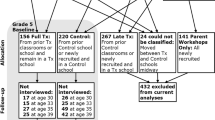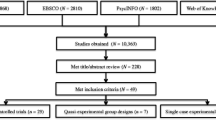Abstract
This study has two objectives: (1) to report the results of a large-scale, longitudinal evaluation of the WITS Programs that included a large sample of elementary school children (n = 1967) from 27 rural schools (including 16 program schools) and (2) to examine and discuss the effects of average developmental trajectories and of heterogeneity in children’s development on intervention outcomes. Data comprise baseline (spring) and four follow-up assessments (5 Waves) from children (N = 1967) and their parents and teachers. WITS stands for Walk away Ignore, Talk it out, and Seek Help (www.witsprograms.com). The children in the intervention schools declined more slowly than those in the control schools in their reports of relational victimization. Children in the intervention schools also declined faster in aggression and emotional problems relative to children in control schools. Moderation analyses showed that intervention group children with higher baseline levels of emotional problems declined faster in emotional problems than those with lower problems at baseline. In addition, children in grades 3 and over completed school climate questionnaire and children in control schools who had more negative perceptions of school climate at baseline showed greater increases in these negative perceptions compared to children in the intervention schools. We discuss the potential impact of average trajectories of child development and the within-child heterogeneity in assessments for the interpretation of the findings. We also conclude by highlighting evaluation design modifications that may improve our future ability to examine the effects of preventive interventions for elementary school children.


Similar content being viewed by others
References
Bradshaw, C. P., Mitchell, M. M., & Leaf, P. J. (2010). Examining the effects of school wide positive behavioral interventions and supports on student outcomes: Results from a randomized controlled effectiveness trial in elementary schools. Journal of Positive Behavior Interventions, 12, 133–148. https://doi.org/10.1177/1098300709334798
Bryk, A. S., & Raudenbush, S. W. (1987). Application of hierarchical linear models to assessing change. Psychological Bulletin, 101, 147–158. https://doi.org/10.1037/0033-2909.101.1.147
Caldwell, C. B., & Pianta, R. (1991). A measure of young children's problem and competence behaviors: The early school behavior scale. Journal of Psychoeducational Assessment, 9(1), 32–44. https://doi.org/10.1177/073428299100900103
Crick, N. R., & Grotpeter, J. K. (2018). Children's treatment by peers: Victims of relational and overt aggression. Developmental and Psyschopathology, 8(2), 367–380. https://doi.org/10.1017/S0954579400007148
Desjardins, T., Yeung Thompson, R. S., Sukhawathanakul, P., Leadbeater, B. J., & MacDonald, S. W. (2013). Factor structure of the Social Experience Questionnaire across time, sex, and grade among early elementary school children. Psychological Assessment, 25, 1058–1068. https://doi.org/10.1037/a0033006
Dong, N., Reinke, W. M., Herman, K. C., Bradshaw, C. P., & Murray, D. W. (2016). Meaningful effect sizes, intraclass correlations, and proportions of variance explained by covariates for planning two- and three-level cluster randomized trials of social and behavioral outcomes. Evaluation Review, 40, 334–377. https://doi.org/10.1177/0193841X16671283
Eddy, J. M. (2017). Facing a fundamental problem in prevention science: The measurement of a key construct. Prevention Science, 18, 322–325. https://doi.org/10.1007/s11121-017-0747-7
Flannery, D. J., & Farrell, A. D. (2019). Evaluating school-based violence prevention programs: Challenges and opportunities now and into the future. In M. J. Mayer & S. R. Jimerson (Eds.), School safety and violence prevention: Science, practice, policy. (pp. 297–323). Washington, DC: APA. https://doi.org/10.1037/0000106-013
Gaffney, H., Ttofi, M. M., & Farrington, D. P. (2018). Evaluating the effectiveness of school-bullying prevention programs: An updated meta-analytical review. Aggression and Violent Behavior., 45, 111–133. https://doi.org/10.1016/j.avb.2018.07.001
Giesbrecht, G. F., Leadbeater, B. J., & MacDonald, S. S. (2011). Child and context characteristics in trajectories of physical and relational victimization among early elementary school children. Development and Psychopathology, 23, 239–252. https://doi.org/10.1017/S0954579410000763
Gottfredson, D. C., Cook, T. D., Gardner, F. E. M., Gorman-Smith, D., Howe, G. W., Sandler, I. N., & Zafft, K. M. (2015) Standards of evidence for efficacy, effectiveness, and scale-up research in prevention science: Next generation. Prevention Science, 16(7), 893–926. https://doi.org/10.1007/s11121-015-0555-x
Hamaker, E. L., van Hattum, P., Kuiper, R. M., & Hoijtink, H. (2011). Model selection based on information criteria in multilevel modeling. In J. J. Hox & J. K. Roberts (Eds.), Handbook for advanced multilevel analysis (pp. 231–255). Routledge/Taylor & Francis Group.
Haynes, N. M., Emmons, C., & Ben-Avie, M. (1997). School climate as a factor in students adjustment and achievement. Journal of Education & Psychological Consultation, 8(3), 321–329. https://doi.org/10.1207/s1532768xjepc0803_4
Henry, D., Tolan, P., Gorman-Smith, D., & Schoeny, M. (2017). Alternatives to randomized control trial designs for community-based prevention evaluation. Prevention Science, 18, 671–680. https://doi.org/10.1007/s11121-016-0706-8
Hoeppner, B. B., & Proeschold-Bell, R. J. (2012). Time-series analysis in community-oriented research. In L. Jason & D. Glenwick (Eds.). Methodological approaches to community-based research. (pp. 125–145).Washington, DC APA. https://doi.org/10.1037/13492-008
Huitsing, G., Lodder, G. M. A., Browne, W. J., Oldenburg, B., Van der Ploeg, R., & Veenstra, R. (2020).A large-scale replication of the KiVa anti-bullying program: A randomized controlled trial in the Netherlands. Prevention Science, 21, 627–638.
Kim, J., & Seltzer, M. (2011). Examining heterogeneity in residual variance to detect differential response to treatments. Psychological Methods, 16, 192–208. https://doi.org/10.1037/a0022656
Leadbeater, B. J., & Hoglund, W. L. G. (2009). The effects of peer victimization and physical aggression on changes in internalizing from first to third grade. Child Development, 80(3), 843–859. https://doi.org/10.1111/j.1467-8624.2009.01301.x
Leadbeater, B. J., & Sukhawathanakul, P. (2011). Multi-component programs for reducing peer victimization in early elementary school: A longitudinal evaluation of the WITS Primary program. Journal of Community Psychology, 39, 606–620. https://doi.org/10.1002/jcop.20447
Leadbeater, B. J., Thompson, K., & Sukhawathanakul, P. (2016). Enhancing social responsibility and prosocial leadership to prevent aggression, peer victimization, and emotional problems in elementary school children. American Journal of Community Psychology, 58, 365–376. https://doi.org/10.1002/ajcp.12092
Low, S., Smolkowski, K., Cook, C., & Desfosses, D. (2019). Two-year impact of a universal social-emotional learning curriculum: Group differences from developmentally sensitive trends over time. Developmental Psychology, 55, 415–433. https://doi.org/10.1037/dev0000621.supp
Morrow, M. T., Hubbard, J. A., & Sharp, M. K. (2019). Preadolescents’ daily peer victimization and perceived social competence: Moderating effects of classroom aggression. Journal of Clinical Child and Adolescent Psychology, 48, 716–727. https://doi.org/10.1080/15374416.2017.1416618
Muthén, L. K., & Muthén, B. O. (1999–2017). Mplus user’s guide, version 8. Los Angeles: Muthén and Muthén.
Rast, P., & Hofer, S. M. (2014). Longitudinal design considerations to optimize power to detect variances and covariances among rates of change: Simulation results based on actual longitudinal studies. Psychological Methods, 19, 133–154. https://doi.org/10.1037/a0034524
Raudenbush, S. W., & Liu, X. (2000). Statistical power and optimal design for multisite randomized trials. Psychological Methods, 5, 199–213. https://doi.org/10.1037/1082-989X.5.2.199
Reinke, W. M., Herman, K. C., & Dong, N. (2018). The incredible years teacher classroom management program: Outcomes from a group randomized trial. Prevention Science. https://doi.org/10.1007/s11121-018-0932-3
Reynolds, C. R., & Kamphaus, R. W. (2004). BASC-2: Behavior assessment system for children. Minneapolis, MN: NCS Pearson.
Ross, K. M., Kim, H., Tolan, P. H., & Jennings, P. A. (2019). An exploration of normative social and emotional skill growth trajectories during adolescence. Journal of Applied Developmental Psychology, 62, 102–115. https://doi.org/10.1016/j.appdev.2019.02.006
Rush, J., & Hofer, S. M. (2017). Design-based approaches for improving measurement in developmental science. Monographs of the Society for Research in Child Development, 82, 67–83. https://doi.org/10.1111/mono.12299
Salmivalli, C. (2010). Bullying and the peer group: A review. Aggression and Violent Behavior, 15, 112–120. https://doi.org/10.1016/j.avb.2009.08.007
Sørlie, M.-A., Idsoe, T., Ogden, T., Olseth, A. R., & Torsheim, T. (2018). Behavioral trajectories during middle childhood: Differential effects of the school-wide Positive Behavior Support Model. Prevention Science., 19, 1055–1065. https://doi.org/10.1007/s11121-018-0938-x
Sliwinski, M. J. (2008). Measurement-burst designs for social health research. Social and Personality Psychology Compass, 2, 245–261. https://doi.org/10.1111/j.1751-9004.2007.00043.x
Sukhawathanakul, P., & Leadbeater, B. (2020). Trajectories of peer victimization in elementary school children: Associations with changes in internalizing, externalizing, social competence, and school climate. Journal of Community Psychology. https://doi.org/10.1002/jcop.22365
Tanner-Smith, E. E., Durlak, J. A., & Marx, R. A. (2018). Empirically based mean effect size distributions for universal prevention programs targeting school-aged youth: A review of meta-analyses. Prevention Science., 19, 1091–1101. https://doi.org/10.1007/s11121-018-0942-1
Wang, L. P., & Maxwell, S. E. (2015). On disaggregating between-person and within-person effects with longitudinal data using multilevel models. Psychological Methods, 20, 63–83. https://doi.org/10.1037/met0000030
Acknowledgements
We appreciate the leadership, support, and enthusiasm of Drs. David Smith and Tina Daniels and of Allison Richards and Evelyn Roxburgh in guiding the program implementation and data collection. We also thank participating schools, parents, teachers, and children for their patience with and dedication to this research.
Funding
This research was funded by the Public Health Agency of Canada’s Innovation Strategy — Taking Action to Reduce Health Inequalities in Canada.
Author information
Authors and Affiliations
Corresponding author
Ethics declarations
Informed Consent
Informed Consent was obtained from parents or guardians of children and from their teachers.
Research Involving Human Subjects
All procedures and measures were approved by the University of Victoria Human Subjects Review Board. This study was performed in accordance with the ethical standards as laid down in the 1964 Declaration of Helsinki and its later amendments or comparable ethical standards.
Conflict of Interest
The first author is the developer and evaluator of the WITS Programs and has received federal research grants for the evaluation of the program.
Additional information
Publisher's Note
Springer Nature remains neutral with regard to jurisdictional claims in published maps and institutional affiliations.
Supplementary Information
Below is the link to the electronic supplementary material.
Rights and permissions
About this article
Cite this article
Leadbeater, B., Sukhawathanakul, P., Rush, J. et al. Examining the Effectiveness of the WITS Programs in the Context of Variability in Trajectories of Child Development. Prev Sci 23, 538–551 (2022). https://doi.org/10.1007/s11121-021-01327-3
Accepted:
Published:
Issue Date:
DOI: https://doi.org/10.1007/s11121-021-01327-3




